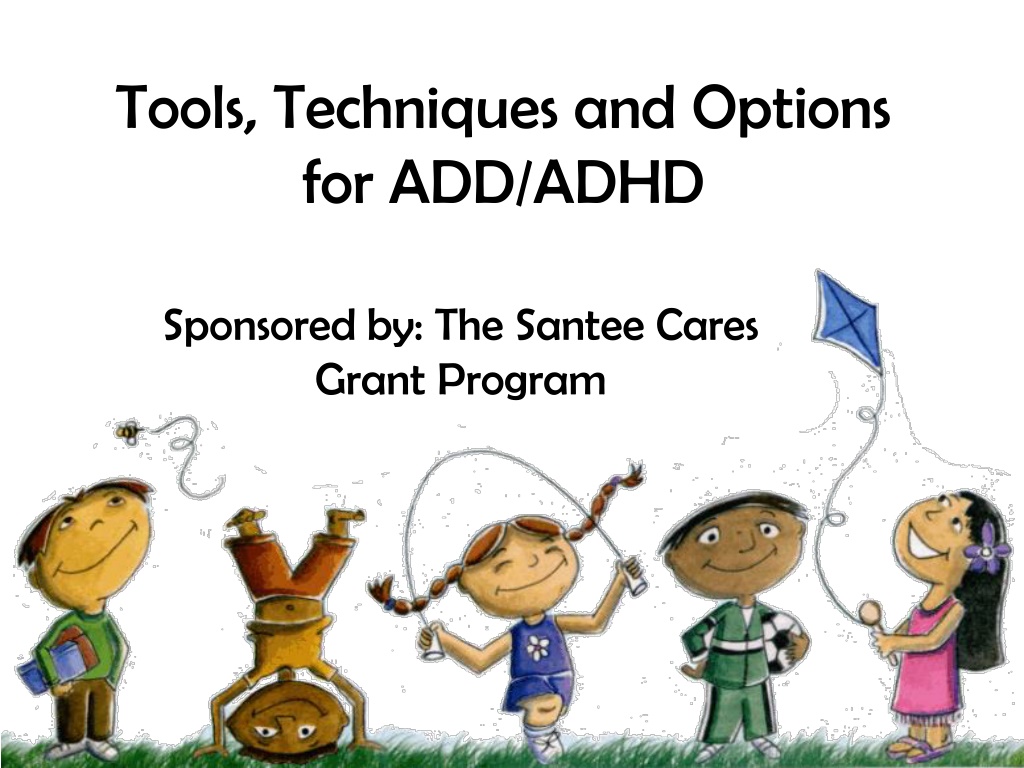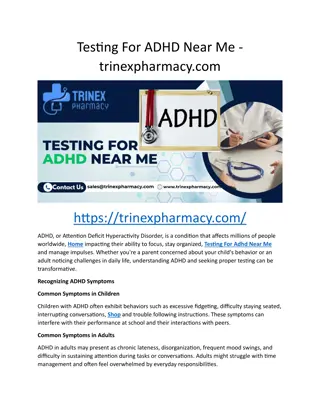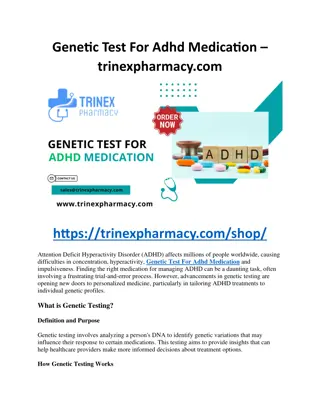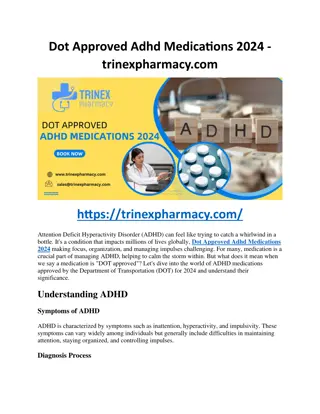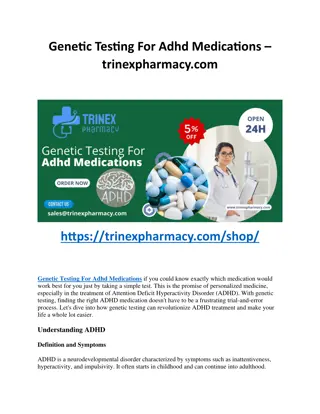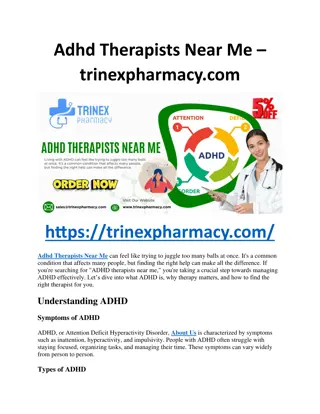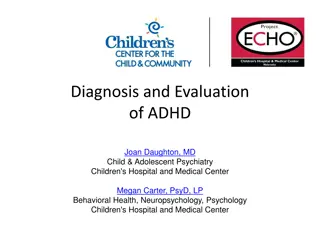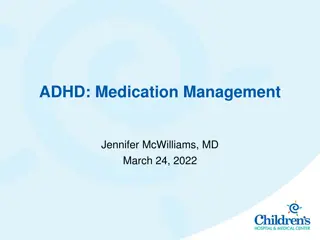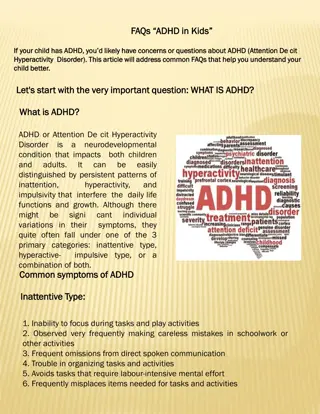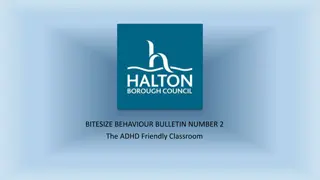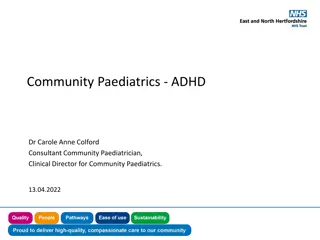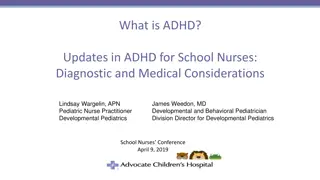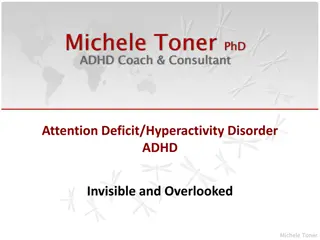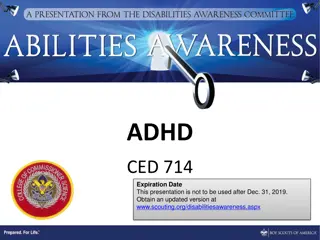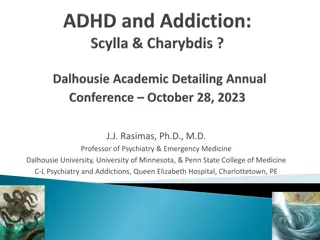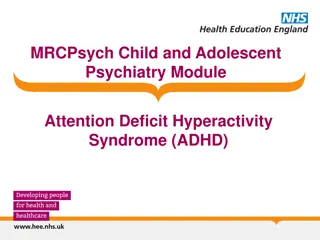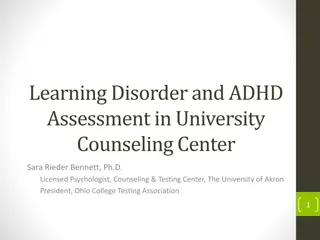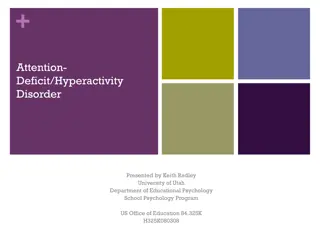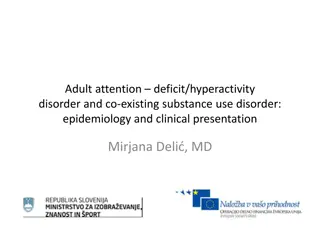Understanding ADHD: Tools, Techniques, and Options
This resource sponsored by The Santee Cares Grant Program delves into essential aspects related to ADD/ADHD, including diagnostic criteria, prevalence among children, common behaviors, and best treatment approaches. It emphasizes the importance of a multi-faceted and collaborative treatment strategy involving medical, psychological, educational, and parental support for children with ADHD.
Download Presentation

Please find below an Image/Link to download the presentation.
The content on the website is provided AS IS for your information and personal use only. It may not be sold, licensed, or shared on other websites without obtaining consent from the author. Download presentation by click this link. If you encounter any issues during the download, it is possible that the publisher has removed the file from their server.
E N D
Presentation Transcript
Tools, Techniques and Options for ADD/ADHD Sponsored by: The Santee Cares Grant Program
Agenda Quick review of basic concepts Treatment decisions/choices Techniques for classroom/homework Tools to help build confidence Parent group formation
Official Diagnostic Criteria: ADD (Inattention) Child must exhibit 6 or more of the following: 1. Often fails to give closer attention to details or makes careless mistakes in schoolwork or other activities. 2. Often has difficulty sustaining attention in tasks or play activities. 3. Often does not appear to listen when spoken to directly. 4. Often does not follow through on instructions and fails to finish school work, chores, or duties. 5. Often has difficulty organizing tasks and activities. 6. Often avoids, dislikes, or is reluctant to engage in tasks requiring sustained mental effort (such as schoolwork or homework). 7. Often loses things necessary for tasks or activities (for example, toys, school assignments, pencils, books or tools). 8. Is often easily distracted by extraneous stimuli. 9. Often forgetful in daily activities.
Official Diagnostic Criteria: Hyperactivity/Impulsivity Child must exhibit 6 or more of the following: 1. Often fidgets with hands or feet or squirms in seat. 2. Often leaves seat in classroom or in other situations in which remaining seated in expected. 3. Often runs about or climbs excessively in situations in which it is inappropriate. 4. Often has difficulty playing or engaging in leisure activities quietly. 5. Is often on the go or often acts as if driven by a motor. 6. Often talks excessively. 7. Often blurts out answers before questions have been completed. 8. Often has difficulty awaiting turn. 9. Often interrupts or intrudes on others (for example, butts into conversations or games).
What Is Currently Known Estimates of ADHD prevalence among school aged children: 3-12% No one has all of the symptoms or displays the disorder in exactly the same way. Diagnosed at least 3x more frequently in boys than girls. Research is showing that many more girls actually have ADHD and are not being diagnosed.
What Is Currently Known (Continued ) Behaviors stem from their disorder. Rarely willful or deliberate Children are generally not even aware of their behaviors and how they affect others. ADHD is not laziness or a character flaw.
We also know that Best treatments are multi-faceted and comprehensive: Medical Psychological Educational Best treatments are collaborative: Parents School Physician Mental Health Professional The child
What Is Currently Known (Continued ) The prognosis is alarming if not treated. Without interventions, children with this disorder are at risk for serious social, emotional, behavioral, and academic problems. Prognosis is positive and hopeful when treated. There are many successful individuals in every profession and walks of life!
Jamie Oliver The star chef had ADHD as a child, but he told the Celebrities with Diseases website that healthy eating helps him manage it. Today, he's a huge proponent for healthier school lunches and eliminating junk food from kids' diets as a way to cope with attention disorders.
Group Activity Jamie Oliver used his talents to become an extremely rich and successful chef and TV personality, even with ADHD. What positive attributes does your child have that you think will help them be successful one day? How could you, as a parent, help highlight and strengthen those characteristics?
Positive Traits and Characteristics Highly energetic Creative/Inventive Artistic Imaginative Empathic Resourceful Not boring Negotiators Intelligent/Bright Charismatic Full of spunk Passionate Outgoing Ready for action
Treatment Options Medication Psycho-Social (Therapy) Alternative Treatments
Medication Stimulant Medications Most common, advised first choice. Increased production of neuro-transmitters in the brain to more normalized level. Proven beneficial: 80-90% Finding the right medication and dose. Medications Ritalin Dexedrine Adderall Dextrostat Concerta Methylin Metadate Focalin
Medication Tricyclic Antidepressants Second-line choice of meds May be best for: Co-existing conditions Children who have side effects to stimulant Medications Imipramine Desiprimine Amytriptyline Nortiptyline Benefits include reduction of hyperactivity and impulsivity, plus: Mood swings Anxiety Depression
Research on Psycho-Social Treatments Direct Contingency Management Positive and negative contingencies are applied directly to child by teachers/counselors. Clinical Behavior Therapy Most common- includes therapist training teachers/parents in behavior Prompting and positively attending to appropriate behavior Consistent corrective consequences to inappropriate behaviors Coordinating programs between home/school Requires big commitment Social Skills Training Children are directly taught social skills and given opportunities to practice and rewarded.
Alternative Treatments Parents need to be cautious and informed consumers when considering alternative treatments. Forms of alternative treatment include: Special diets Supplements of megavitamins Chiropractic skull manipulation Biofeedback Herbal remedies Hypnosis
Group Activity Please take a few moments to share with your table: What treatments are you currently using? Is it helping? What s your feedback? What treatments are you considering? What treatments have you heard about?
Techniques and Strategies Positive Discipline Behavior Management Rewards and Positive Reinforcers for Home Homework Tips for Parents Classroom Techniques
Positive Discipline/Behavior Management Provide structure, routine, and predictability Set limits and mean business! Establish a few rules/expectations that are understood clearly Make it a goal to catch child being good at least once a day, more is better! Reinforce desired behavior with a positive consequences (praise, smiles, hugs, privileges)
Rewards and Reinforcers Used at Chet Class applause Tutoring younger children First in line Classroom free-time Chance to tell appropriate jokes in class Study/sit with friend
Effective Punishments/Consequences Ignoring (specifically attention-getting behaviors) Verbal reprimands (not yelling and screaming) Removal of privileges Response costs (points, etc) Timeout Separate behavior from character
Group Activity What are some creative rewards you use with your child? What are some consequences that you ve found to work well? What is homework time like at your house?
Homework Techniques Quiet workspace Limit distractions and reduce unnecessary noise Work with them to establish best time and place Develop routine! Assist with getting started Ask to see what they ve accomplished (time)
Chet F. Harritt Classroom Techniques Weekly report cards Reinforcers/Consequences Periodic desk/notebook checks (weekly) Providing examples Accommodations for learning styles Visual Auditory Kinesthetic
Top 30 Tips for Parents 1. Make sure what you re dealing with really is AD/HD 2. Build your support. 3. Know your limits. 4. Structure 5. Post rules 6. Repeat directions 7. Make frequent eye contact. 8. Set limits, boundaries
Top 30 Tips for Parents 9. Have predictable schedule as possible. 10.Special care for transitions 11. Allow for escape valves. 12. Provide frequent feedback 13. Break down large tasks. 14. Loosen up! Act silly! 15. But watch out for over-stimulation.
Top 30 Tips for Parents 16. Seek out and underscore success as much as possible. 17. Use tricks to improve memory. 18. Announce what you are going to say before you say it. Say it. Then say what you have said. 19. Simplify instructions. Simplify choices. 20. Use feedback that helps child become self-observant. AD/HD children often have no idea how they come across or how they have been behaving. Try to give them this information in a constructive way. Ask questions like Do you know what just happened? or How do you think you might have said that differently? or Why do you think that other girl looked sad when you said what you said?
Top 30 Tips for Parents 21. Make expectations explicit. 22. Children with AD/HD respond to rewards and incentives. 23. Try discreetly to offer specific and explicit advise as a sort of social coaching. 24. Make a game out of things when possible. 25. Give responsibility back to child when possible. 26. Praise, stroke, approve, encourage, nourish. 27. Be like the conductor of a symphony. Get the orchestra s attention before beginning.
Top 30 Tips for Parents 28. Expect to repeat, repeat, repeat. 29. Provide for exercise. One of the best treatments for AD/HD, in both children and adults, is exercise, preferable vigorous exercise. Exercise helps work off excess energy, it helps focus attention, it stimulates certain hormones and neurochemicals that are beneficial, and it is fun. 30. Always be on the lookout for sparkling moments! These kids are far more talented and gifted than they often seem. They are full of creativity, play, spontaneity, and good cheer. They usually have a special something that enhances whatever setting they re in.
Methods for Building Confidence Fun and Laughter Breathing Techniques Yoga and Slow-Movement Exercises Visualization and Guided Imagery Music Leisure Activities, Recreation and Hobbies Exercise
Resources Terry Wilke, LCSW (619) 300-8498 BRAKES: Interactive Newsletter for Kids with ADHD www.maginationpress.com www.CHADD.net Meetings in Clairemont, Chula Vista, Encinitas, Rancho Penisquitos
